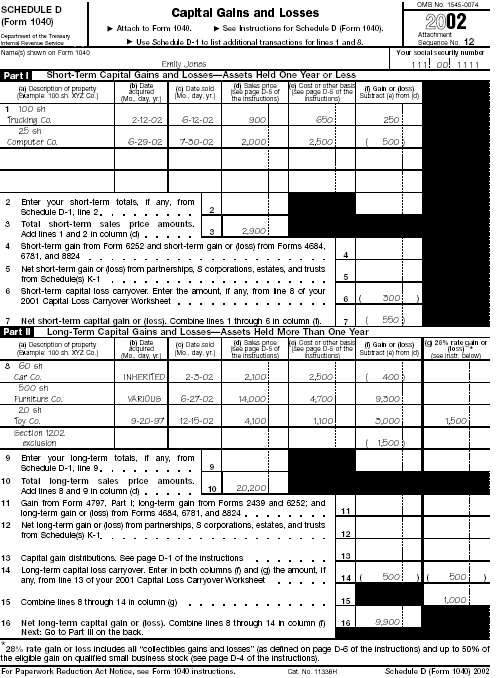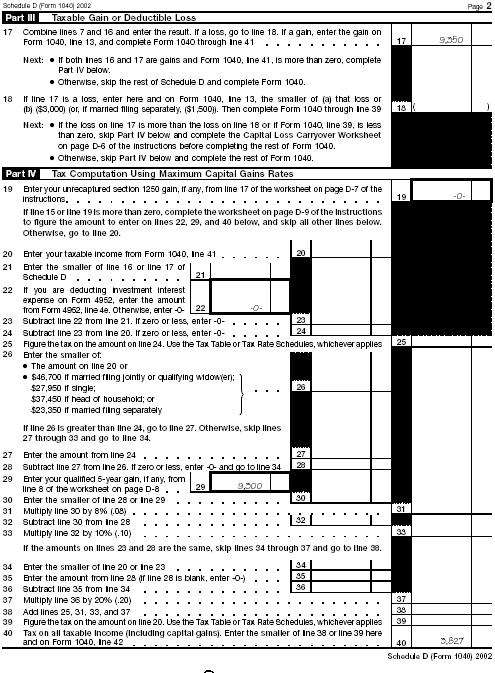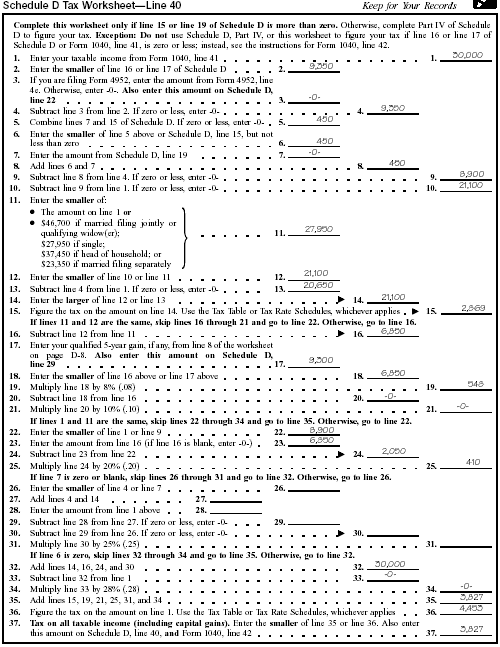Comprehensive Example
Emily Jones is single and, in addition to wages from her job, she has income from stocks and other securities. For the 2002 tax year, she had the
following capital gains and losses, which she reports on Schedule D. All the Forms 1099 she received showed net sales prices. Her filled-in Schedule D
is shown in this chapter.
Capital gains and losses - Schedule D.
Emily sold stock in two different companies that she held for less than a year. In June, she sold 100 shares of Trucking Co. stock that she had
bought in February. She had an adjusted basis of $650 in the stock and sold it for $900, for a gain of $250. In July, she sold 25 shares of Computer
Co. stock that she bought in June. She had an adjusted basis in the stock of $2,500 and she sold it for $2,000, for a loss of $500. She reports these
short-term transactions on line 1 in Part I of Schedule D.
Emily had three other stock sales that she reports as long-term transactions on line 8 in Part II of Schedule D. In February, she sold 60 shares of
Car Co. for $2,100. She had inherited the Car Co. stock from her father. Its fair market value at the time of his death was $2,500, which became her
basis. Her loss on the sale is $400. Because she had inherited the stock, her loss is a long-term loss, regardless of how long she and her father
actually held the stock. She enters the loss in column (f) of line 8.
In June, she sold 500 shares of Furniture Co. stock for $14,000. She had bought 100 of those shares in 1991, for $1,000. She had bought 100 more
shares in 1993 for $2,200, and an additional 300 shares in 1996 for $1,500. Her total basis in the stock is $4,700. She has a $9,300 ($14,000 -
$4,700) gain on this sale, which she enters in column (f) of line 8. Because she held all 500 shares for more than 5 years, the entire gain is
qualified 5-year gain.
In December, she sold 20 shares of Toy Co. for $4,100. This was qualified small business stock that she had bought in September 1997. Her basis is
$1,100, so she has a $3,000 gain which she enters in column (f) of line 8. Because she held the stock more than 5 years, she has a $1,500 section 1202
exclusion. She enters that amount in column (g) as a 28% rate gain and claims the exclusion on the line below by entering $1,500 as a loss in column
(f).
She received a Form 1099-B (not shown) from her broker for each of these transactions.
Capital loss carryover from 2001.
Emily has a capital loss carryover to 2002 of $800, of which $300 is short-term capital loss, and $500 is long-term capital loss. She enters these
amounts on lines 6 and 14 of Schedule D.
She kept the completed Capital Loss Carryover Worksheet in her 2001 Schedule D instructions (not shown), so she could properly report
her loss carryover for the 2002 tax year without refiguring it.
Tax computation.
Because Emily has gains on both lines 16 and 17 of Schedule D and has taxable income, she goes to Part IV of Schedule D to figure her tax. But
because line 15 of Schedule D is more than zero (due to her section 1202 gain from selling qualified small business stock), she must use the
Schedule D Tax Worksheet to figure her tax instead. She must also complete the Qualified 5-Year Gain Worksheet (not shown) in
her Schedule D instructions.
After entering the gain from line 17 on line 13 of her Form 1040, she completes the rest of Form 1040 through line 41. She enters the amount from
that line, $30,000, on line 1 of the Schedule D Tax Worksheet. After filling out the rest of that worksheet, she figures her tax is $3,827. This is
less than the $4,453 tax she would have figured without the capital gain tax rates.
Reconciliation of Forms 1099-B.
Emily makes sure that the total of the amounts reported in column (d) of lines 3 and 10 of Schedule D is not less than the total of the amounts
shown on the Forms 1099-B she received from her broker. For 2002, the total is $23,100.

Schedule (Form 1040): D, page 1

Schedule D, page 2

Cap Gain Worksheet
Adjustments to Income
The three chapters in this part discuss three of the adjustments to income that you can deduct in figuring your adjusted gross income. These
chapters cover:
- Contributions you make to traditional individual retirement arrangements (IRAs) - chapter 18,
- Moving expenses you pay - chapter 19, and
- Alimony you pay - chapter 20.
Other adjustments to income are discussed in other parts of this publication or in other publications and instructions. They are deductions for:
- Educator expenses - instruction for Form 1040 line 23, Form 1040A line 16,
- Interest paid on student loans - Publication 970,
- Tuition and fees deduction - Publication 970,
- Contributions to an Archer MSA - chapter 23,
- Self-employment tax - chapter 24,
- Self-employed health insurance - chapter 23,
- Payments to self-employed SEP, SIMPLE, and qualified plans - Publication 560, Retirement Plans for Small Business,
- Penalty on early withdrawal of savings - chapter 8,
- Amortization of the costs of reforestation - chapter 9 of Publication 535, Business Expenses,
- Contributions to Internal Revenue Code section 501(c)(18) pension plans - Publication 525, Taxable and Nontaxable
Income,
- Expenses from the rental of personal property - chapter 13,
- Expenses of fee-basis officials or certain performing artists - chapter 28,
- Certain required repayments of supplemental unemployment benefits (sub-pay) - chapter 13,
- Foreign housing deduction - chapter 4 of Publication 54, Tax Guide for U.S. Citizens and Resident Aliens
Abroad,
- Jury duty pay given to your employer - chapter 13,
- Part of the cost of qualified clean-fuel vehicle property - chapter 12 of Publication 535, Business Expenses,
and
- Contributions by certain chaplains to Internal Revenue Code section 403(b) plans - Publication 517, Social Security and Other
Information for Members of the Clergy and Religious Workers.
Individual Retirement Arrangements (IRAs)
Important Changes for 2002
Increased traditional IRA contribution and deduction limit.
Unless you reached age 50 before 2003, the most that can be contributed to your traditional IRA for 2002 is the smaller of the following amounts:
- Your compensation that you must include in income for the year, or
- $3,000 (up from $2,000).
If you reached age 50 before 2003, the most that can be contributed to your traditional IRA for 2002 is the smaller of the following amounts:
- Your compensation that you must include in income for the year, or
- $3,500 (up from $2,000).
For more information, see How Much Can Be Contributed? under Traditional IRAs.
Besides being able to contribute a larger amount for 2002, you may be able to deduct a larger amount. See How Much Can I Deduct? under
Traditional IRAs.
Modified AGI limit for traditional IRA contributions increased.
For 2002, if you are covered by a retirement plan at work, your deduction for contributions to a traditional IRA will be reduced (phased out) if
your modified adjusted gross income (AGI) is between:
- $54,000 and $64,000 for a married couple filing a joint return or a qualifying widow(er),
- $34,000 and $44,000 for a single individual or head of household, or
- $-0- and $10,000 for a married individual filing a separate return.
For all filing statuses other than married filing separately, the upper and lower limits of the phaseout range increased by $1,000. See
How Much Can I Deduct? under Traditional IRAs.
Credit for IRA contributions.
For tax years beginning after 2001, if you are an eligible individual, you may be able to claim a credit for a percentage of your qualified
retirement savings contributions, such as contributions to your traditional or Roth IRA. To be eligible, you must be at least 18 years old as of the
end of the year, and you cannot be a student or an individual for whom someone else claims a personal exemption. Also, your adjusted gross income
(AGI) must be below a certain amount.
For more information, see chapter 38.
Rollovers of distributions from employer plans.
For distributions after 2001, you can roll over both the taxable and nontaxable part of a distribution from a qualified plan into a traditional
IRA. If you have both deductible and nondeductible contributions in your IRA, you will have to keep track of your basis so you will be able to
determine the taxable amount once distributions from the IRA begin.
For more information, see Can I Move Retirement Plan Assets? under Traditional IRAs.
Kinds of rollovers from a traditional IRA.
For distributions after 2001, you can roll over, tax free, a distribution from your traditional IRA into a qualified plan, including a deferred
compensation plan of a state or local government (section 457 plan), and a tax-sheltered annuity (section 403(b) plan). The part of the distribution
that you can roll over is the part that would otherwise be taxable (includible in your income). Qualified plans may, but are not required to, accept
such rollovers. For more information, see Rollovers under Can I Move Retirement Plan Assets.
Rollovers of deferred compensation plans of state and local governments (section 457 plans) into traditional IRAs.
Before 2002, you could not roll over, tax free, an eligible rollover distribution from a governmental deferred compensation plan into a traditional
IRA.
Beginning with distributions after 2001, if you participate in an eligible deferred compensation plan of a state or local government, you may be
able to roll over part or all of your account tax free into an eligible retirement plan such as a traditional IRA. The most that you can roll over is
the amount that qualifies as an eligible rollover distribution. The rollover may be either direct or indirect.
For more information, see Kinds of rollovers to a traditional IRA under Rollovers.
Participants born before 1936.
If you were born before 1936, you may be able to use capital gain and averaging treatment on certain lump-sum distributions from qualified plans,
but you will lose the opportunity to use capital gain or averaging treatment on distributions from a qualified plan if you roll over IRA contributions
to that plan. You can retain such treatment if the rollover is from a conduit IRA. For more information on conduit IRAs, see IRA as a holding
account (conduit IRA) for rollovers to other eligible plans under Rollover From Employer's Plan Into an IRA in chapter 1 of
Publication 590.
No rollovers of hardship distributions into IRAs.
For distributions made after 2001, no hardship distribution can be rolled over into an IRA. For more information about what can be rolled over, see
Rollover From Employer's Plan Into an IRA under Can I Move Retirement Plan Assets.
Hardship exception to the 60-day rollover rule.
Generally, a rollover is tax free only if you make the rollover contribution by the 60th day after the day you receive the distribution. Beginning
with distributions after 2001, the IRS may waive the 60-day requirement where it would be against equity or good conscience not to do so.
For more information, see Time limit for making a rollover contribution under Rollovers.
Increased Roth IRA contribution limit.
If contributions on your behalf are made only to Roth IRAs, your contribution limit for 2002 generally is the lesser of:
- $3,000 (up from $2,000), or
- Your taxable compensation.
If you are 50 years of age or older in 2002 and contributions on your behalf are made only to Roth IRAs, your contribution limit for 2002 generally
is the lesser of:
- $3,500 (up from $2,000), or
- Your taxable compensation.
However, if your modified AGI is above a certain amount, your contribution limit may be reduced. For more information, see How Much Can Be
Contributed? under Roth IRAs.
Contributions to both traditional and Roth IRAs for same year.
If contributions are made on your behalf to both a Roth IRA and a traditional IRA, your contribution limit for 2002 is the lesser of:
- $3,000 ($3,500 if you are 50 years of age or older in 2002) (up from $2,000) minus all contributions (other than
employer contributions under a SEP or SIMPLE IRA plan) for the year to all IRAs other than Roth IRAs, or
- Your taxable compensation minus all contributions (other than employer contributions under a SEP or SIMPLE IRA plan) for the year to all
IRAs other than Roth IRAs.
However, if your modified AGI is above a certain amount, your contribution limit may be reduced. For more information, see How Much Can Be
Contributed? under Roth IRAs.
Change in exception to the age 59½ rule.
Generally, if you are under age 59½, you must pay a 10% additional tax on the distribution of any assets from your traditional IRA.
However, if you receive distributions as part of a series of substantially equal payments over your life (or life expectancy), or over the lives (or
the joint life expectancies) of you and your beneficiary, you do not have to pay this additional tax even if your receive distributions before you
reach age 59½. If these payments are changed (for any reason other than death or disability) before the later of the date
you reach age 59½ or 5 years after the first payment, you generally are subject to the 10% additional tax. You must pay the full amount
of the additional tax that would have been due if your payments had not been substantially equal periodic payments. You must also pay interest. If
your series of substantially equal periodic payments began before 2003, you can change your method of figuring your payment to the required minimum
distribution method at any time without incurring the additional tax. For distributions beginning in 2002, and for any series of payments beginning
after 2002, if you began receiving distributions using either the amortization method or the annuity factor method, you can make a one-time switch to
the required minimum distribution method without incurring the additional tax. For more information, see Age 59½ Rule and
its exceptions in chapter 1 of Publication 590. Rules for figuring your required minimum distribution are explained under Minimum
Distributions in chapter 1 of Publication 590.
Important Changes for 2003
Modified AGI limit for traditional IRAs.
For 2003, if you are covered by a retirement plan at work, your deduction for contributions to a traditional IRA will be reduced (phased out) if
your modified adjusted gross income (AGI) is between:
- $60,000 and $70,000 for a married couple filing a joint return or a qualifying widow(er),
- $40,000 and $50,000 for a single individual or head of household, or
- $-0- and $10,000 for a married individual filing a separate return.
For all filing statuses other than married filing separately, the upper and lower limits of the phaseout range increase by $6,000. For more
information, see How Much Can I Deduct? under Traditional IRAs.
Deemed IRAs.
For plan years beginning after 2002, a qualified employer plan (retirement plan) can maintain a separate account or annuity under the plan (a
deemed IRA) to receive voluntary employee contributions. If the separate account or annuity otherwise meets the requirements of an IRA, it will only
be subject to IRA rules. An employee's account can be treated as a traditional IRA or a Roth IRA.
For this purpose, a qualified employer plan includes:
- A qualified pension, profit-sharing, or stock bonus plan (section 401(a) plan),
- A qualified employee annuity plan (section 403(a) plan),
- A tax-sheltered annuity plan (section 403(b) plan), and
- A deferred compensation plan (section 457(b) plan) maintained by a state, a political subdivision of a state, or an agency or
instrumentality of a state or political subdivision of a state.
Simplified rules for required minimum distributions.
There are new rules for determining the amount of a required minimum distribution for a year beginning after 2002. The new rules, including new
life expectancy tables, have been incorporated into Publication 590. See When Must I Withdraw IRA Assets? in chapter 1 of Publication 590.
Previous| First | Next
Publication 17 | 2002 Tax Year Archives | Tax Help Archives | Home
